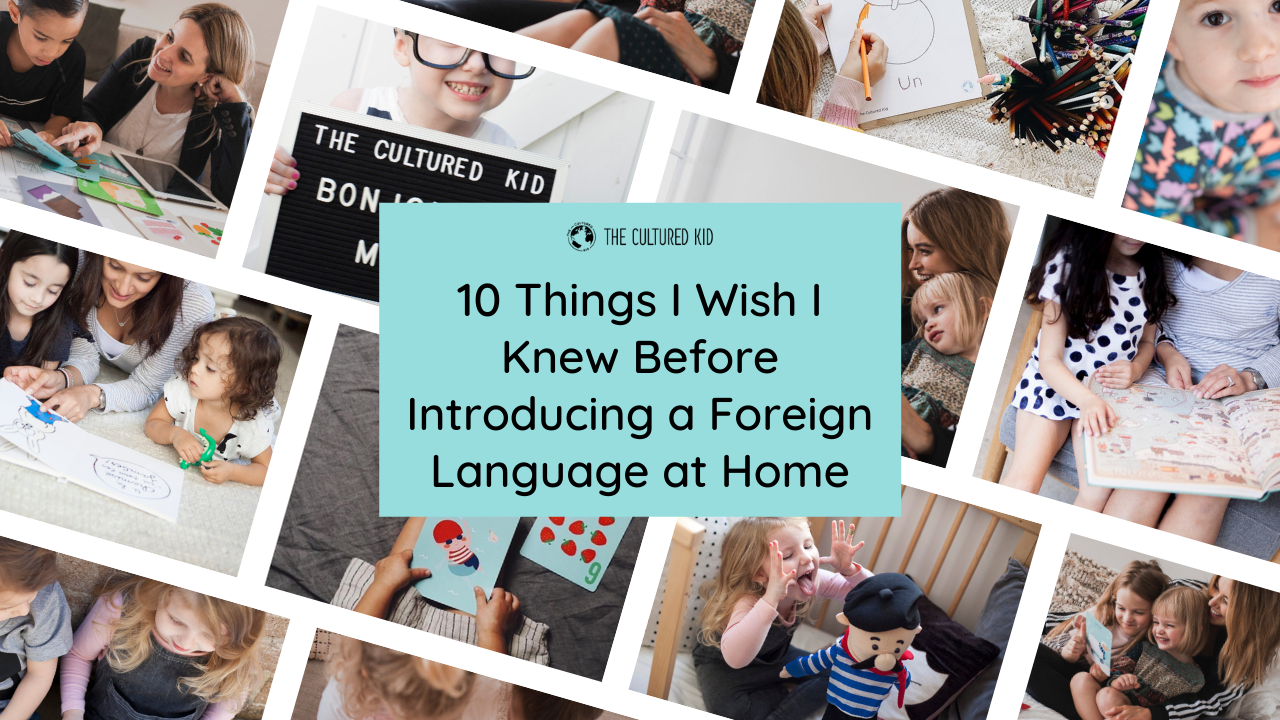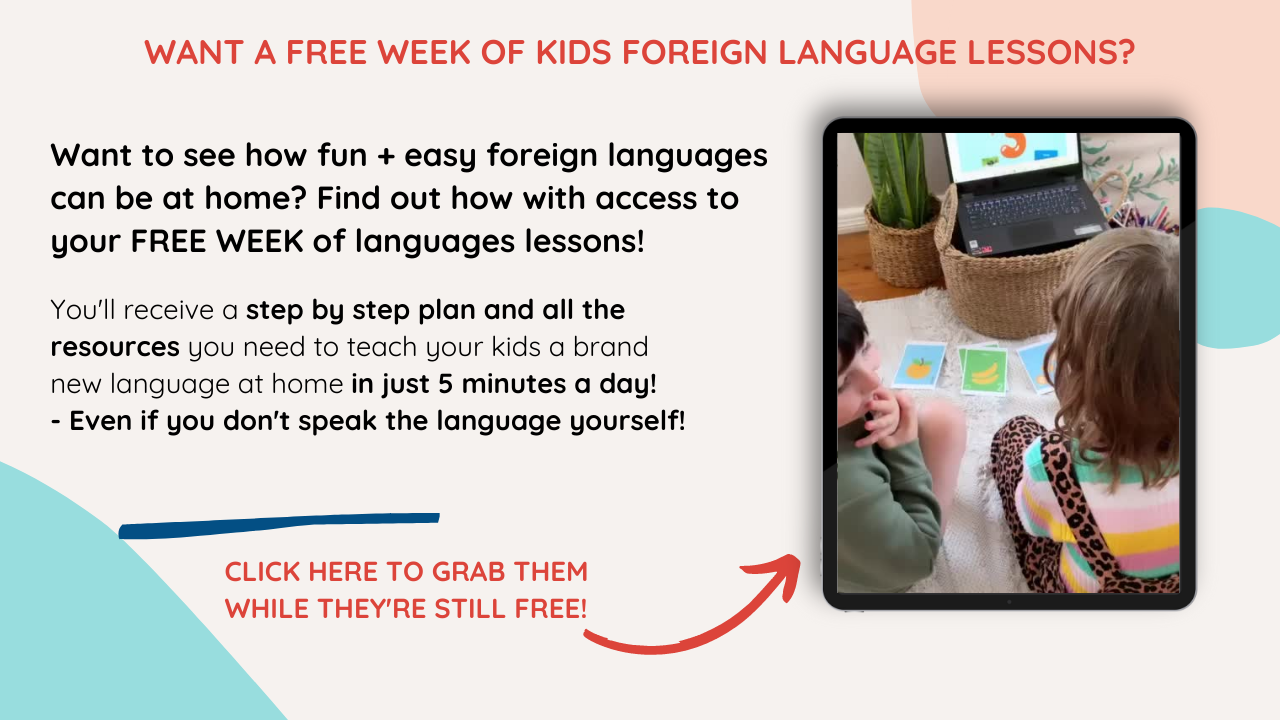10 Things I Wish I Knew Before Introducing a Foreign Language at Home

10 Things I Wish I Knew Before Introducing a Foreign Language at Home
Whether you have been teaching your kids a new language at home for a while now or only just started, I think we all can agree there were a few shocks to the system that nobody had prepared you for. Research and prepare as you may, but there will always be a few unexpected bumps in the road that most parents had to learn the hard way.
That is why I wanted to take the time and make a list of all the important things that nobody told me before I got started, things that I have learned over the years of teaching my kids a new language at home so you don’t have to approach this task like a minefield.
- All kids have different learning speeds
If you only have one child at home then this will not be an issue for you, but if you have two or more kids, you will have to keep in mind that they won’t all necessarily learn this new language at the same pace, which may create a gap in their levels of proficiency.
When I first started out, I started to notice that my younger daughter picked up the new words a bit quicker than my older son, but my older son had better pronunciation so I had to figure out how to go forward from there. You can choose one of two ways to go about this situation.
The first is that you can spend extra time outside of the designated time slot that you have set aside for teaching your kids, to review with your child that is making slower progress to get them all back on the same level before the next lesson.
The second is that you can continue to teach them at different levels, which will mean that you will have to set aside two separate time slots in which to teach your kids individually on the level that they are each comfortable with.
- Each child responds to a different teaching medium/method
Throughout your own years of learning you would most likely have discovered that there is a specific type of medium that you best respond to when learning. For some it may be visual through reading, flashcards or videos and for others it could be audio through songs and music. When it comes to successfully teaching your kids a new language, it is definitely not a one size fits all kind of deal.
When you are teaching your kids, it will make all the difference in the world if you firstly take some time to find out which medium works best for each of your kids.
Once you apply these mediums to your teaching style, you will see a rapid increase in the amount of new content that your kids can remember and retain long term.
- You have to make time to be consistent
Learning a new language is not like building a puzzle, where you can make progress, put it aside for a few weeks and just continue again where you left off without losing any progress. This is something that we as parents can sometimes forget when we just get started; our kids’ progress is dependent on our time and effort that we put into teaching them.
Consistency is key if you truly want your kids to make real progress. It can happen to all of us when you have a busy day full of work and appointments, picking up the groceries, taking your kids to the dentist, getting the car fixed, making dinner and then having absolutely no energy or motivation to give a fun and entertaining language lesson to your kids.
Take some time once or twice a week to go through your weekly schedule and designate a specific time slot for you and your kids to learn. Make sure to choose a time that you know you will be motivated and prepared to spend on teaching your kids.
- You will become an entertainer
You are not giving a lecture to a bunch of university students that can just be informative and straightforward, oh no, you are teaching your energetic, playful and easily distracted young kiddos. Let me just say that this was one of the biggest transformations for me that no one prepared me for.
For most young children to stay interested when they are learning a new language, they have to be entertained. Now for me that meant turning into a rock star in my living room singing French songs with my kids (admittedly I did enjoy feeling like Brittany Spears for parts of the day).
For you that might mean turning into a magician and playing card games with some vocabulary flashcards or being an actor while acting through some scenarios with your kids practicing the target language of the day.
The point is to just be creative and enjoy every minute of this journey with your kids, whether you are simply being yourself or a more entertaining version.
- It’s not just once a day, it’s all day
This might seem like a bit of an exaggeration, but it’s not quite as daunting as it sounds.
Yes, you have your designated 1-2 hour time slot for teaching, but you will see a lot more progress in your kids when you immerse yourselves in the new language. Kids’ brains have a way of working like a puzzle and when you continue to use the language in different scenarios throughout the day, their minds can put the pieces together to really understand what they are learning, rather than just repeating what they hear. If your lesson this morning was about food, use lunch time at the table to play restaurant and have your kids order food in the new language.
Perhaps your lesson was about household items, then you can write the names of different household items on post-it notes, in the afternoon tell them to go place the notes on the correct items and in the evening tell them to go collect the notes off of the right items.
The more you use the language throughout the day, the easier it will be for your kids to become fluent.
- Resources are your best friend
The days where teaching simply consisted of a textbook are long gone. There are so many new and entertaining resources at your disposal to make your family’s teaching experience engaging and highly entertaining.
Now this doesn’t mean that you should run off and go to buy some fancy and expensive toys and materials, that won’t be necessary. There are thousands of parents that went through the exact same process as you and have spent months or even years collecting resources that worked best for their kids, most of them free.
These resources could be anything from songs, engaging storybooks all the way to fun board games or activity sheets.
Try as many as you can to find out what works best for your family and if your kids eventually get bored of it, you can simply change to a different kind of resource, there are definitely enough to go around.
- Get a support system
We are parents, bosses, employees, cooks, cleaners, pet caretakers and now also teachers. Needless to say things can get a bit overwhelming at times and the next thing you know, you’re hiding in your bathroom with your Woman’s Health magazine and a KitKat that you snuck into your basket when you were at the supermarket earlier today.
This is where your support system comes into play. Make sure you have someone to talk to and sometimes vent about things when your days get a bit rough. It can be your partner, your parents, a friend or even a social media group that shares your kind of journey.
When I first got started, I tried doing it all on my own and as you would expect, that led to countless stressful episodes of tears. When you have a support system and you talk to them, they can often open your eyes to new possibilities or solutions to problems that you were worried about.
There is absolutely no reason to do this alone, you can always find support.
- Your entire house will become a classroom
So this may be one of the more drastic and visible side effects of teaching a language at home, which admittedly I was not fully prepared for. I am used to running a very neat and organized home, but once you teach at home, that tends to change a bit.
Three months in and I found myself staring at flashcards scattered all over the living room floor, post-it notes on every other household item that I laid my eyes on, storybooks in heaps on my bedside table, worksheets on the bathroom sink and tablets in the kitchen playing Baby Shark in French at top volume.
The most important part about this is that it didn’t bother me, because I realized that I have the best entertaining, engaging and fun classroom that most teachers would be jealous of.
You have unlimited opportunities and resources when you have an entire house to work with, just be prepared for a little bit of chaos every now and then.
- You don’t have to be a native speaker yourself to teach your kids
Now this golden nugget of information will really knock your socks off!
That’s right, you don’t have to be a native speaker of the language you want to teach your kids before you teach it to them. This is a common misperception and I’ve had countless parents coming to me asking how they can teach their kids this language if they are not native speakers or can’t even speak the language at all.
The thing is you don’t actually have to be able to speak the language you want to teach your kids, you just have to be willing to try.
Most of the time these parents ended up enjoying learning the new language almost more than the kids did, because they were learning alongside their kids instead of focusing on how they were supposed to teach it with no prior knowledge.
- Reviewing is just as important as teaching new content
This may come as a surprise, but if my many years of teaching experience have taught me anything, it’s the importance of reviewing content that you have already taught.
The human brain has a way of sifting through new information, establishing if you’re using it or not and then deciding to dispose of it or retain it. So if you teach your kids a few new words and you don’t take the time to use those words throughout the day or week and you don’t review it again, their brains will be less likely to retain those words and your efforts would have been wasted.
If you start off by implementing a review session after every few lessons from the beginning, it will save you a lot of frustration later down the road.
I honestly wish I had this golden fountain of information when I first started teaching my kids at home, it would definitely have made the process a lot smoother, but it’s never too late.
There is no such thing as too late when it comes to learning new tips and tricks to teach at home. No matter how far down the road you are, you can always change, tweak or improve your methods or strategies.
It could even be that you may know a few tricks that could help someone else or that you are someone else’s support system.
You will always have the opportunity to either learn or teach so make the best of it.
Now that you have the cheat codes to the game, you are ready to play so let’s get started!
Looking for fun lesson resources to help take the pressure off you and maximixe FUN learning with your kids?

✨ Psst... When you're ready, here are a few ways I can help you get started with teaching your kids a foreign language at home...
1. Download my free 10 Page Guide for Parents to help you see how easy introducing a foreign language at home can be - especially if you don't speak the language at all.
2. Want a plan to run consistent language lessons that are fun and easy?
Access your first week of play based foreign language lessons for FREE here, all that's left is to select your language + start today!
3. Looking for a 12 month, step-by-step plan and play based resources to help you introduce a language to your little ones with EASE? Quit scrolling on Pinterest and Join our 12 Month Annual Lesson Bundles to get everything you need to started and KEEP GOING!
GRAB OUR FREE 'KIDS LANGUAGES MADE EASY' GUIDE
FOR NON-NATIVE PARENTS!
Discover how you can run consistent language lessons, that are fun and engaging and help your kids make the progress they deserve!
Even if you're not fluent!
We hate SPAM. We will never sell your information, for any reason.









